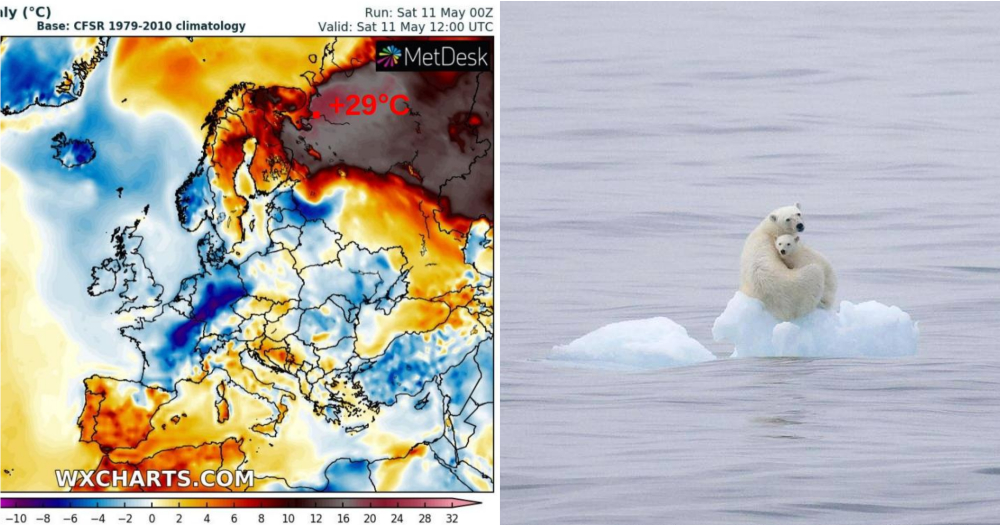The Arctic is the northernmost region where wild polar bears are found.
It is very well one of the coldest places on Earth.
However, a Northern Russian city, Arkhangelsk, near the Arctic Circle, was recorded with abnormally high temperatures recently.
Hit 29°C near Arctic Circle
Temperatures in Arkhangelsk were reported to have hit 29°C on May 11, 2019 when the typical temperature should have been 12°C.
25.2°C in Ilomantsi, Eastern Finland, which is the highest temperature in Finland so far in 2019. And also first "hot day" (defined as daily max T > 25°C) of the year. https://t.co/F26YCawQ26
— Mika Rantanen (@mikarantane) May 11, 2019
This is even warmer than the average daily temperature of the hottest month in Singapore, which was 27°C in February.
The area of Arctic sea ice in April 2019 was also the smallest on record.
And it's not even summer yet.
#Arctic average sea ice coverage for April 2019 was the smallest on record for the month. It was also the 18th consecutive April that Arctic sea ice was below avg: @NOAANCEIclimate https://t.co/yALppCyNno #StateOfClimate pic.twitter.com/dMrHJBuFvX
— NOAA (@NOAA) May 20, 2019
While the heat wave on May 11 can be attributed to jet streams, the warming climate is undeniable.
The carbon dioxide (CO₂) levels on the same weekend were recorded to have reached an all-time high in human history.
Highest ever in history
The Mauna Loa Observatory in Hawaii, where CO₂ has been recorded daily since 1958, saw the CO₂ levels hit a record high of 415.26 parts per million (ppm) on May 11, 2019.
This is the first time the observatory has recorded a daily baseline above 415 ppm and this might be the highest levels of carbon dioxide measured in 800,000 years.
The levels of CO₂, a greenhouse gas that traps heat in the atmosphere, had been averaging around 230 ppm in the past 800,000 years.
The last time the Earth's atmosphere contained this much CO₂ was more than three million years ago.
CO₂ levels have only shot up to hit past the 400 ppm mark in the recent decade.
 Photo from Scripps Institute of Oceanography
Photo from Scripps Institute of Oceanography
Wolfgang Lucht, a professor from Potsdam Institute for Climate Impact Research in Germany, shared that this is a worrying sign.
"It shows that we are not on track with protecting the climate at all. The number keeps rising and it’s getting higher year after year."
"All of human history has been in a colder climate than now."
Increasing at an increasing rate
Data has shown that CO₂ levels are not just climbing steadily, but exponentially.
The Keeling Curve shows the accumulation of CO₂ over decades.
The jagged pattern on the curve is a result of the intake and release of CO₂ by plants over the seasons.
However, the overall increasing trend of the curve is very likely due to human activities that belch out CO₂.
As indicated on the graph, it took 16 years for CO₂ levels to increase by 15ppm between the 1960s and 1970s.
However, it only took six years from 2010 onwards for CO₂ levels to increase by the same amount.
CO₂ concentration is accelerating. pic.twitter.com/gHzpV7nHnc
— Kevin Pluck (@kevpluck) May 4, 2019
Ralph Keeling, a professor at one of the most established research centres on this field, Scripps Institute of Oceanography, said the historic rise in atmospheric CO₂ is undeniably due to human activity, mainly as a result of fossil fuel burning:
“Few if any natural processes can release fossil carbon into the atmosphere as fast as we humans are doing it now via the extraction and burning of fossil fuels."
Impending climate crisis
The warming climate brings about a whole host of negative repercussions, such as a mass extinction of species.
Besides extinction, drastic changes in climate also brings about unpredictable weather and natural disasters, which can affect food security and public health, for example.
A decrease in CO₂ levels seems almost impossible, but scientists like Lucht hope that, at the very least, levels can be maintained:
"Any value that we can manage to stabilise at is a win."
Top photo from Mika Rantanen and Ira Meyer Photography via Deep Green Resistance Facebook
If you like what you read, follow us on Facebook, Instagram, Twitter and Telegram to get the latest updates.
